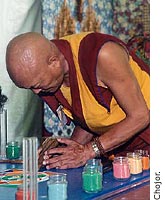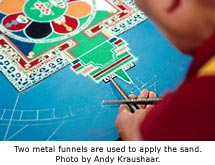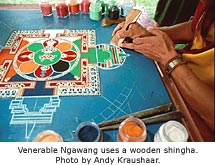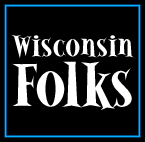Tibetan Buddhist Arts
Madison, WI
What kind of art do you make?
 Sometimes
art tells a story. Sometimes art teaches a lesson. Sometimes art decorates
tools. Sometimes art decorates a space. Sometimes art expresses emotions.
Sometimes art shows history. Sometimes
art tells a story. Sometimes art teaches a lesson. Sometimes art decorates
tools. Sometimes art decorates a space. Sometimes art expresses emotions.
Sometimes art shows history.
Ven. Ngawang’s mandalas do different things in different times and places. For
a Tibetan Buddhist religious ceremony, Ven. Ngawang makes mandalas for
celebration and meditation. For cultural
demonstrations, Ven. Ngawang makes mandalas to teach people about Tibetan
culture.
Does Ven. Ngawang create new mandala designs when he makes one? No, he uses
ancient patterns first taught by Siddhartha Gautama, the Buddha, about 2,600
years ago. The lines, shapes and colors for each mandala were recorded in texts.
Ven. Ngawang memorized these texts during  his
studies at the Namgyal Monastery. Now he makes mandalas from memory. his
studies at the Namgyal Monastery. Now he makes mandalas from memory.
Tools, Technique, and Time
 Ven.
Ngawang starts a mandala by making an outline. He uses a ruler, a pen with
silver ink, and two different types of compasses to draw the outline. He draws
it on something sturdy, like plywood. This is the base of the mandala, called a theg-pu.
The smallest mandala Ven. Ngawang makes is about three feet square
and the largest is about six feet square. Ven.
Ngawang starts a mandala by making an outline. He uses a ruler, a pen with
silver ink, and two different types of compasses to draw the outline. He draws
it on something sturdy, like plywood. This is the base of the mandala, called a theg-pu.
The smallest mandala Ven. Ngawang makes is about three feet square
and the largest is about six feet square.
Ven. Ngawang uses colored sand for filling in the mandala outline. Ven. Ngawang
makes colored sand by first crushing white sand and soft sandstone to make a
powder. He adds vegetable dyes or water-based colors. Then he mixes the colored
sands with ground-up precious powders and blesses the sand before using
it.
Ven. Ngawang makes three shades each of yellow, red, green and blue, plus black and white. Listen to Ven. Ngawang talk about the
meaning of the mandala’s colors. You can read along by clicking here.
red, green and blue, plus black and white. Listen to Ven. Ngawang talk about the
meaning of the mandala’s colors. You can read along by clicking here.
 Ven.
Ngawang uses the sand to create the mandala. He fills in the empty spaces with
layers of intricate designs. He uses two metal funnels to apply the sand. Each
funnel has bumpy ridges on top. He holds one of the funnels exactly where he
wants to put the sand and uses the other funnel to rub against the first one,
creating friction. The friction makes the sand fall slowly onto the exact place
he wants it. A tool he uses to make straight edges is a wooden shingha.
Ven. Ngawang must be meticulous
and have steady hands to make a good mandala. Ven.
Ngawang uses the sand to create the mandala. He fills in the empty spaces with
layers of intricate designs. He uses two metal funnels to apply the sand. Each
funnel has bumpy ridges on top. He holds one of the funnels exactly where he
wants to put the sand and uses the other funnel to rub against the first one,
creating friction. The friction makes the sand fall slowly onto the exact place
he wants it. A tool he uses to make straight edges is a wooden shingha.
Ven. Ngawang must be meticulous
and have steady hands to make a good mandala.
Click on the video icon to watch how Ven. Ngwang adds details to a mandala he’s
making. The video clip has no words.
 Ven.
Ngawang often makes a mandala with other monks. It often takes several days.
They usually say different prayers while they’re making the mandala. They
display the mandala for a few days and then the monks cut the sand, sweep it
into a vase, and carry it to body of water. They pour the sand into the water,
so that all the prayers in the mandala can go out to the world. Buddhists
believe in impermanence.
Taking the mandala apart reminds people that nothing lasts forever. Ven.
Ngawang often makes a mandala with other monks. It often takes several days.
They usually say different prayers while they’re making the mandala. They
display the mandala for a few days and then the monks cut the sand, sweep it
into a vase, and carry it to body of water. They pour the sand into the water,
so that all the prayers in the mandala can go out to the world. Buddhists
believe in impermanence.
Taking the mandala apart reminds people that nothing lasts forever.
Take a look at this slide show to see Ven. Ngawang dismantling a mandala. He and
his translator Tsering Namgyal made the mandala in Madison as part of the 1998
Wisconsin Folklife Festival.

 |


 Sometimes
art tells a story. Sometimes art teaches a lesson. Sometimes art decorates
tools. Sometimes art decorates a space. Sometimes art expresses emotions.
Sometimes art shows history.
Sometimes
art tells a story. Sometimes art teaches a lesson. Sometimes art decorates
tools. Sometimes art decorates a space. Sometimes art expresses emotions.
Sometimes art shows history.
 Ven.
Ngawang starts a mandala by making an outline. He uses a ruler, a pen with
silver ink, and two different types of compasses to draw the outline. He draws
it on something sturdy, like plywood. This is the base of the mandala, called a theg-pu.
The smallest mandala Ven. Ngawang makes is about three feet
Ven.
Ngawang starts a mandala by making an outline. He uses a ruler, a pen with
silver ink, and two different types of compasses to draw the outline. He draws
it on something sturdy, like plywood. This is the base of the mandala, called a theg-pu.
The smallest mandala Ven. Ngawang makes is about three feet  Ven.
Ngawang uses the sand to create the mandala. He fills in the empty spaces with
layers of intricate designs. He uses two metal funnels to apply the sand. Each
funnel has bumpy ridges on top. He holds one of the funnels exactly where he
wants to put the sand and uses the other funnel to rub against the first one,
creating friction. The friction makes the sand fall slowly onto the exact place
he wants it. A tool he uses to make straight edges is a wooden shingha.
Ven. Ngawang must be
Ven.
Ngawang uses the sand to create the mandala. He fills in the empty spaces with
layers of intricate designs. He uses two metal funnels to apply the sand. Each
funnel has bumpy ridges on top. He holds one of the funnels exactly where he
wants to put the sand and uses the other funnel to rub against the first one,
creating friction. The friction makes the sand fall slowly onto the exact place
he wants it. A tool he uses to make straight edges is a wooden shingha.
Ven. Ngawang must be  Ven.
Ngawang often makes a mandala with other monks. It often takes several days.
They usually say different prayers while they’re making the mandala. They
display the mandala for a few days and then the monks cut the sand, sweep it
into a vase, and carry it to body of water. They pour the sand into the water,
so that all the prayers in the mandala can go out to the world. Buddhists
believe in
Ven.
Ngawang often makes a mandala with other monks. It often takes several days.
They usually say different prayers while they’re making the mandala. They
display the mandala for a few days and then the monks cut the sand, sweep it
into a vase, and carry it to body of water. They pour the sand into the water,
so that all the prayers in the mandala can go out to the world. Buddhists
believe in 